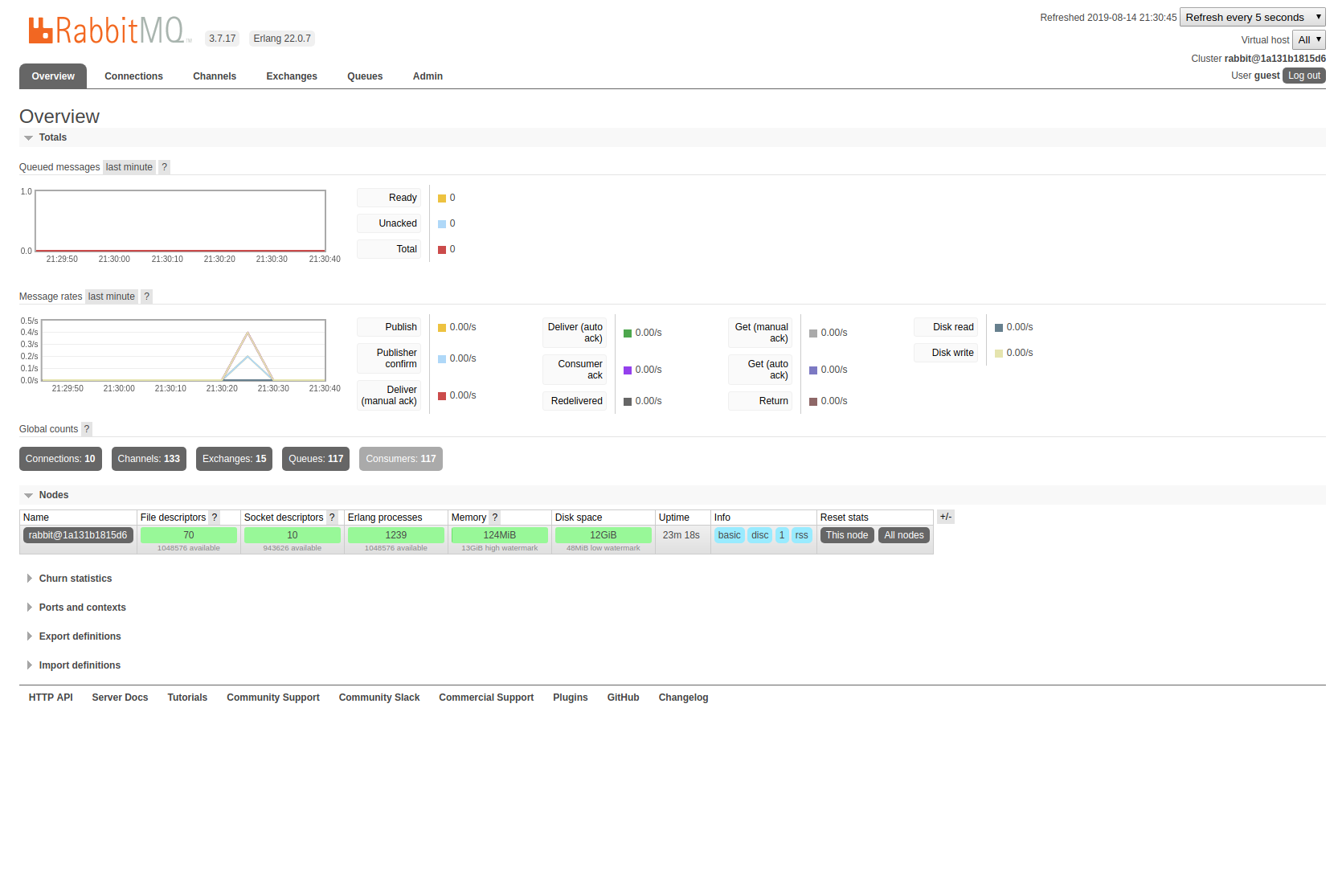Overview
Adds the set of conventions and ease of use for RabbitMQ integration with .NET Core.

Installation
dotnet add package Convey.MessageBrokers.RabbitMQ
Dependencies
Options
Provides RabbitMQ integration based on the official RabbitMQ .NET Client with highly customizable settings, support for custom naming conventions, templating, dead letter exchange and many more.
appsettings.json
"rabbitMq": {
"connectionName": "some-service",
"retries": 3,
"retryInterval": 2,
"conventionsCasing": "snakeCase",
"logger": {
"enabled": true
},
"username": "guest",
"password": "guest",
"virtualHost": "/",
"port": 5672,
"hostnames": [
"localhost"
],
"requestedConnectionTimeout": "00:00:30",
"requestedHeartbeat": "00:01:00",
"socketReadTimeout": "00:00:30",
"socketWriteTimeout": "00:00:30",
"continuationTimeout": "00:00:20",
"handshakeContinuationTimeout": "00:00:10",
"networkRecoveryInterval": "00:00:05",
"exchange": {
"declare": true,
"durable": true,
"autoDelete": false,
"type": "topic",
"name": "stories"
},
"queue": {
"declare": true,
"durable": true,
"exclusive": false,
"autoDelete": false,
"template": "some-service/."
},
"context": {
"enabled": true,
"header": "message_context"
},
"deadLetter": {
"enabled": true,
"prefix": "dlx-",
"declare": true
},
"maxProducerChannels": 1000,
"requeueFailedMessages": false,
"spanContextHeader": "span_context"
},
Usage
Inside Startup.cs extend IConveyBuilder with AddRabbitMq() that will register the required services.
public IServiceProvider ConfigureServices(this IServiceCollection services)
{
var builder = services.AddConvey()
.AddRabbitMq();
//other registrations
return builder.Build();
}
The above registration creates a unique connection to RabbitMQ and registers services required for publishing and subscribing the messages.
To subscribe to a particular message, invoke UseRabbitMq() method on IApplicationBuilder and call Subscribe<TMessage>() passing a function which is going to be executed once the message got received.
public void Configure(this IApplicationBuilder app)
{
app.UseRabbitMq()
.Subscribe<MyMessage>(async (serviceProvider, message, context) =>
{
//put your "on received" code here
});
}
Once you subscribe to message a coresponding RabbitMQ topic, exchange and routing key should be created using the following conventions:
Exchange-{options.exchange.name}Queue-{options.queue.template}Routing key-{messageType}
The conventions can be overriden either by providing the custom implementation of IConventionsBuilder:
public interface IConventionsBuilder
{
string GetRoutingKey(Type type);
string GetExchange(Type type);
string GetQueue(Type type);
}
Or by applying [Message] attribute on top of the class e.g.
[Message("users")]
public class UserCreated : IEvent
{
public Guid UserId { get; }
public string Name { get; }
public UserCreated(Guid userId, string name)
{
UserId = userId;
Name = name;
}
}
To publish a message simply inject IBusPublisher into any class you want and invoke PublishAsync() (or make use IRabbitMqClient) passing the message and the additional parameters,
public class CustomBusPublisher
{
private readonly IBusPublisher _publisher;
public CustomBusPublisher(IBusPublisher publisher)
{
_publisher = publisher;
}
public Task PublishMessageAsync<T>(T message) => _publisher.PublishAsync(message);
}
Error handling
During message processing there might be a chance that an exception will be thrown. We can distinguish two types of exceptions:
domain exception- informs that message cannot be further processed due to some domain logic like.PasswordToShortExceptioninfrastructure exception- informs that message cannot be further processed due to infrastructure issues like. connecting to database etc.
In the first scenario, it’s better not to retry the processing (wrong password is not going to be better once we try again). n the second one, we can try a few times before we give up. Convey allows you to add this type of error handling using a simple mapper. Create a class that implements IExceptionToMessageMapper interface and register it in IConveyBuilder:
public class ExceptionToMessageMapper : IExceptionToMessageMapper
{
public object Map(Exception exception, object message)
{
switch (exception)
{
// do simple pattern matching
}
return null;
}
}
// Startup.cs
public IServiceProvider ConfigureServices(this IServiceCollection services)
{
var builder = services.AddConvey()
.AddRabbitMq()
.AddExceptionToMessageMapper<ExceptionToMessageMapper>();
//other registrations
return builder.Build();
}
If an exception will be thrown during message processing, a mapper is used to produce another message that will be automatically published to RabbitMQ. If exception->message mapping is not be defined, retry is going to be performed according to parameters provided in appsettings.json.
Dead-letter exchange
DLX support can be enabled via options:
"deadLetter": {
"enabled": true,
"prefix": "dlx-",
"declare": true,
"durable": true,
"exclusive": false,
"autoDelete": false,
"ttl": 86400
}
Each message which is not defined as a part of rejected event mapping in IExceptionToMessageMapper, will be published to its own dead letter queue which will be named based on {options.prefix}{queue} e.g. for users queue, there would be dlx-users dead letter queue.
CQRS integration
Convey allows you to integrate asynchronous communication with CQRS principle providing set of extension methods for publishing/subscribing commands and events.
Installation
dotnet add package Convey.MessageBrokers.CQRS
Dependencies
Usage
To subscribe for a particular command or event, invoke UseRabbitMq() method on IApplicationBuilder and call SubscribeCommand<TCommand>() or SubscribeEvent<TCommand>().
public void Configure(this IApplicationBuilder app)
{
app.UseRabbitMq()
.SubscribeCommand<CreateUser>()
.SubscribeEvent<UserCreated>();
}
Once the message is received, it gets distpatched using ICommandDispatcher or IEventDispatcher.
To publish a message simply inject IBusPublsiher into any class you want and invoke SendAsync() (for commands) or PublishAsync() (for event) passing the message and correlation context.
public class CustomBusPublisher
{
private readonly IBusPublisher _publisher;
public CustomBusPublisher(IBusPublisher publisher)
{
_publisher = publisher;
}
public Task PublishCommandAsync<TCommand>(TCommand command) where T : class, ICommand
=> _publisher.SendAsync(command);
public Task PublishEventAsync<TEvent>(TEvent @event) where T : class, IEvent
=> _publisher.PublishAsync(@event);
}
This package also allows you register async dispatcher instead of “in-memory”. Extend IConveyBuilder with AddServiceBusCommandDispatcher() or AddServiceBusEventDispatchermethod:
public IServiceProvider ConfigureServices(this IServiceCollection services)
{
var builder = services.AddConvey()
.AddQueryHandlers()
.AddServiceBusCommandDispatcher()
.AddServiceBusEventDispatcher();
//other registrations
return builder.Build();
}
Jaeger integration
You can easily integrate RabbitMQ messaging with Jaeger using Convey package.
Installation
dotnet add package Convey.Tracing.Jaeger.RabbitMQ
Dependencies
Usage
Add Jaeger options accoridng to Convey.Tracing.Jaeger docs and add plugin using AddJaegerRabbitMqPlugin() method inside RabbtiMq optional plugins registration:
public IServiceProvider ConfigureServices(this IServiceCollection services)
{
var builder = services.AddConvey()
.AddRabbitMq(plugins: p => p.AddJaegerRabbitMqPlugin());
//other registrations
return builder.Build();
}
Inbox + Outbox pattern
Provides exactly-once processing and guaranteed message delivery features based on inbox and outbox patterns. Currently supported storage:
- In memory (mostly for the testing purposes)
- SQL using Entity Framework
dotnet add package Convey.MessageBrokers.Outbox.EntityFramework - Mongo
dotnet add package Convey.MessageBrokers.Outbox.Mongo
public IServiceProvider ConfigureServices(this IServiceCollection services)
{
var builder = services.AddConvey()
.AddMessageOutbox(outbox => outbox.AddMongo());
//other registrations
return builder.Build();
}
"outbox": {
"enabled": true,
"type": "sequential",
"expiry": 3600,
"intervalMilliseconds": 2000,
"inboxCollection": "inbox",
"outboxCollection": "outbox"
}